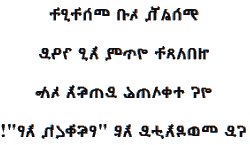Tigrinya love poem
እቲ መስትያት
ምስልኺ ኣብ መስትያት
ዝበለጸት ግጥሚ እያ ንዓይ
ግና ተቀላጠፊ ይጠፍእ ኣሎ
ናይ መወዳእታይ እዩ "የፍቅረኪ እየ"!

A transliteration
məsələhi ʾabə mäsətəyatə
zəbäläs'ätə gət'əmi ʾəya nəʾayə
gəna täqälat'äfi yət'äfəʾə ʾalo
nayə mäwädaʾətayə ʾəyu "yäfəqəräki ʾəyä"!

→ French poem ←
Tigrinya language
Translation of my poem into Tigrigna (Tigrinya, Tigray, Beta Israel, Tigrie, Falashas, Habashi, Autonym : ትግርኛ (Tigrinya)) an ethiosemitic language. Tigrinya, which has 10 million speakers, is spoken in the Tigray region of Ethiopia and Eritrea where it is an official language. It is the direct descendant of the ancient Gueze. Like Amharic, Tigrinya belongs to the Ethiopic branch of the Semitic languages. It is most closely related to Tigre, the other principal language of Eritrea. Tigrigna is written with the pretty Gueze alphabet, common to the languages of the region. I really like this alphabet.
Tigrinya is the second most important language, of the Ethiopian family of Semitic languages. The Ge'ez (classical Ethiopian), who bequeathed to it its writing system, is extinguished. That's only in the middle of the 19th century that it will begin to be written. There are two reasons: Amharic, was the language of the Ethiopian court, and the Ge'ez, was the language of the Christians of Ethiopia. There are important dialectal variants, and the standard of the language is recent, since it dates only from the independence of the Erithrea in 1993.
She has a real sweet voice, cool and quiet, like the simplest of her movements. For her, everything is serene. The time that passes is a friend she savored because she is not beside, but with this nature that surrounds her. On the beach she listens, the wind, the lapping waves, and the birds. She also listens to the sound of the boats. The oldest woman in her village, one day said to her: "After a long travel, lost, HE will land on the beach, behind the dune, distraught, and YOU will tell him: No you are not lost! What you've been looking for so many years is here, and in seeing you, he will know!
History
Eritrea has been a separate country from Ethiopia since 1993. It is the cultural cradle of the Horn of Africa, which for a long time formed the outlet of the Ethiopian kingdom to the sea. The Tigrinya ethnic group (half of population) is the most represented. The Gueze is the ethiopian language once spoken in the kingdom of Aksum, it is still the liturgical language of the Ethiopia's church.
The oldest texts date from the 3rd century, and are written in a consonantal alphabet. In the 4th century, we find inscriptions written with a syllabary which notes the vowels and which is still used today to transcribe the Ethiopian languages. For the Gueze, unlike the other Semitic languages, the direction of writing is from left to right. This language that ceased to be spoken between 900-1200, has survived as a literary language.
Amharic poem